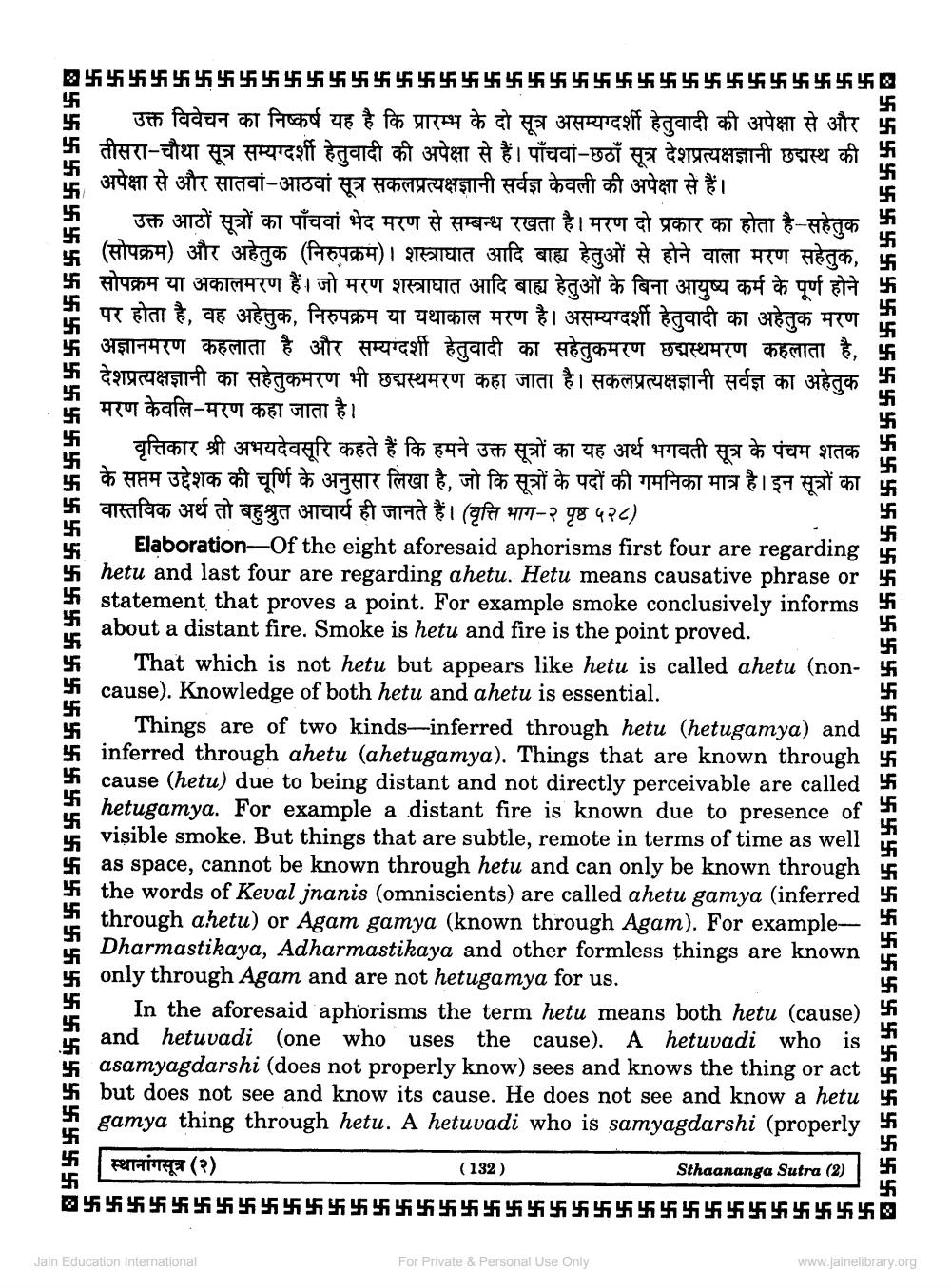________________
B555555555555555555555555555555555555 ॐ उक्त विवेचन का निष्कर्ष यह है कि प्रारम्भ के दो सूत्र असम्यग्दर्शी हेतुवादी की अपेक्षा से और म 卐 तीसरा-चौथा सूत्र सम्यग्दर्शी हेतुवादी की अपेक्षा से हैं। पाँचवां-छठाँ सूत्र देशप्रत्यक्षज्ञानी छद्मस्थ की * अपेक्षा से और सातवां-आठवां सूत्र सकलप्रत्यक्षज्ञानी सर्वज्ञ केवली की अपेक्षा से हैं।
___ उक्त आठों सूत्रों का पाँचवां भेद मरण से सम्बन्ध रखता है। मरण दो प्रकार का होता है-सहेतुक
(सोपक्रम) और अहेतुक (निरुपक्रम)। शस्त्राघात आदि बाह्य हेतुओं से होने वाला मरण सहेतुक, ॐ सोपक्रम या अकालमरण हैं। जो मरण शस्त्राघात आदि बाह्य हेतुओं के बिना आयुष्य कर्म के पूर्ण होने के
पर होता है, वह अहेतुक, निरुपक्रम या यथाकाल मरण है। असम्यग्दर्शी हेतुवादी का अहेतुक मरण ॐ अज्ञानमरण कहलाता है और सम्यग्दर्शी हेतुवादी का सहेतुकमरण छद्मस्थमरण कहलाता है, 5 देशप्रत्यक्षज्ञानी का सहेतुकमरण भी छद्मस्थमरण कहा जाता है। सकलप्रत्यक्षज्ञानी सर्वज्ञ का अहेतुक मरण केवलि-मरण कहा जाता है।
वत्तिकार श्री अभयदेवसरि कहते हैं कि हमने उक्त सत्रों का यह अर्थ भगवती सत्र के पंचम शतक के सप्तम उद्देशक की चूर्णि के अनुसार लिखा है, जो कि सूत्रों के पदों की गमनिका मात्र है। इन सूत्रों का के वास्तविक अर्थ तो बहुश्रुत आचार्य ही जानते हैं। (वृत्ति भाग-२ पृष्ठ ५२८)
Elaboration Of the eight aforesaid aphorisms first four are regarding hetu and last four are regarding ahetu. Hetu means causative phrase or statement that proves a point. For example smoke conclusively informs about a distant fire. Smoke is hetu and fire is the point proved.
That which is not hetu but appears like hetu is called ahetu (noncause). Knowledge of both hetu and ahetu is essential. ___Things are of two kinds-inferred through hetu (hetugamya) and
inferred through ahetu (ahetugamya). Things that are known through i cause (hetu) due to being distant and not directly perceivable are called i
hetugamya. For example a distant fire is known due to presence of visible smoke. But things that are subtle, remote in terms of time as well as space, cannot be known through hetu and can only be known through the words of Keval jnanis (omniscients) are called ahetu gamya (inferred through ahetu) or Agam gamya (known through Agam). For example Dharmastikaya, Adharmastikaya and other formless things are known only through Agam and are not hetugamya for us.
In the aforesaid aphorisms the term hetu means both hetu (cause) and hetuvadi (one who uses the cause). A hetuvadi who is asamyagdarshi (does not properly know) sees and knows the thing or act but does not see and know its cause. He does not see and know a hetu gamya thing through hetu. A hetuvadi who is samyagdarshi (properly
a555 $ $$ $$$$$$$$$$$$$$ $$$$$$$$$$$$$$ $$$$$$$$$$$$ $听听。
स्थानांगसूत्र (२)
(132)
Sthaananga Sutra (2)
ऊ
)
))))))))))))555555555555555
Jain Education International
For Private & Personal Use Only
www.jainelibrary.org




